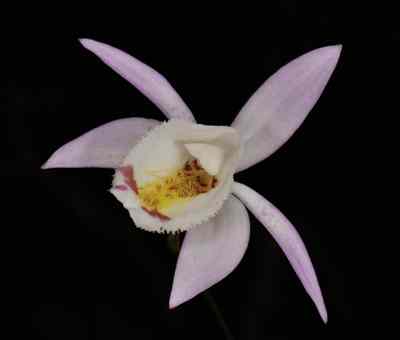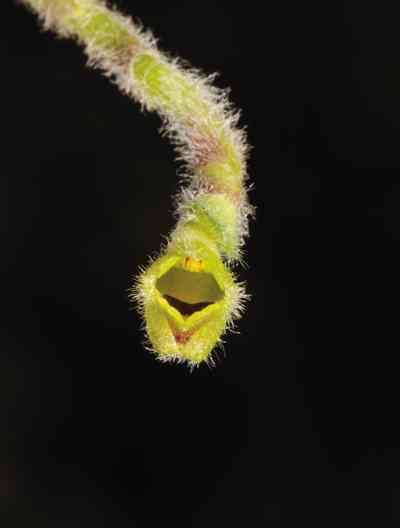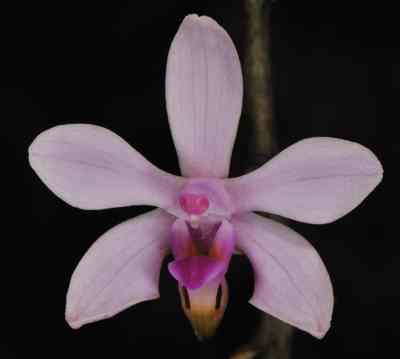The Plant
Epiphyte, with small oval shaped pseudo bulbs covered with a few lax sheaths. Leaf solitary, 3 to 5 cm long and 1 to 1.5 cm cm in width, proceeding from the base of the adult pseudo-bulb, narrowly elliptic, acute, tapering towards the petiole. Leafy during flowering. Peduncle longer than the leaves, enclosed in tubular imbricate sheaths.
The Flower
Flowers solitary, 2 to 3 cm across, floral bract about as long as the stalked ovary, arising from the apex of the pseudo-bulb and protruding through the petiole of the leaf. Sepals spreading, sub-equal in length, elliptic to oblong, the dorsal slightly narrowed than the lateral, five nerved. Petals spreading, narrower and longer than the petals, obtuse, 5 to 7 nerved. Lip sub-reniform, cordate at base, broader in its posterior half, minutely erose in its anterior portion, apex retuse, disc with 7 ciliate ridges from the base to apex. Column long and curved, broadly winged. Pollinia obliquely elliptic.
Sepals and petals are of various shades of pale pink to rose, slightly darkening towards the margins. Lip almost white with a few reddish brown markings on its disc. The ciliate ridges are bright yellow.

The Pursuit
A rather common species of the high altitude hills. I had spotted this species from several hilly areas of the region during my work. In the pre-monsoon days this species creates an interesting view, with hundreds of flowers fully covering many tree trunks. Before my research on orchids of Sikkim-Himalayas, I had noticed this species in full bloom during one of my trips to North Sikkim. The observation of the species in flower from a very high altitude caught our attention and we did some photo shoots. On our way back me and my fellow class mates had a long conversation about the species. Later on, I started my research on orchids and became an almost permanent resident of the region. During its flowering season, I was working from Lachen in North Sikkim and decided to study and document the species from those same trees.
The trees are on the right side of a sharp curve on an ascending road (most of the roads of North Sikkim are uphill only!!!). The sharp curve coupled with the ascending nature of the road makes all vehicles slow down there. Thus the flowers on those trees had bought the attention of all passing by. Even the taxi operators got a scheduled stop there for the tourists to have photo shoots.
I visited the place every time when I went up the road. Finally, the flowers started opening up. My visits turned regular and saw more and more flowers in bloom. My intention was to get maximum blooming flowers in one frame. Finally, I decided the shoot for the next day and also wanted to document the top most growing plant in bloom. The reason was that, this is the highest growing epiphytic orchid of the region at 11,800 ft MSL. That means the top most flower on those trees will be the record bearer for the highest growing epiphytic orchid of the region!!!. Our journey uphill from Lachen was systematically planned with ladder, hooks, ropes, cardboards etc. While in the spot only we realized the fact that the ladder width is around half the diameter of the tree, hence it is difficult for it to hold on to the tree. My driver came up with some ideas to fix the ladder rigidly with some iron wires he found nearby. I and my assistant were right up the tree taking much caution not to destroy any plants on the trunk and branches. I selected the topmost flower, luckily it was a fresh flower too. Shooting was so difficult due to heavy winds. The flower was shivering in the wind, which makes sharp photos impossible. My assistant was kind enough to hold many hardboards on almost all sides to prevent wind and made me produce this wonderful photograph of the species, the highest blooming epiphytic orchid of the region!!!








